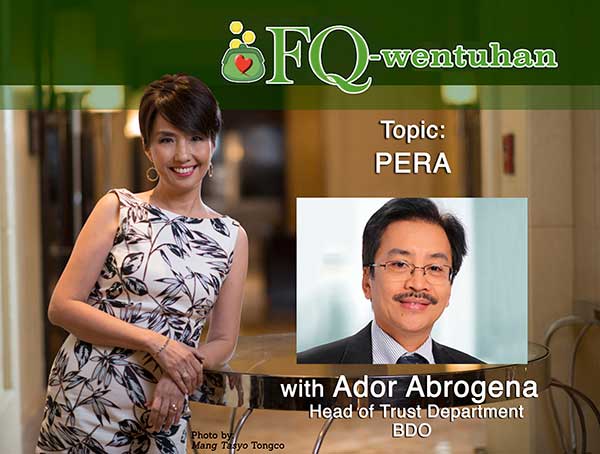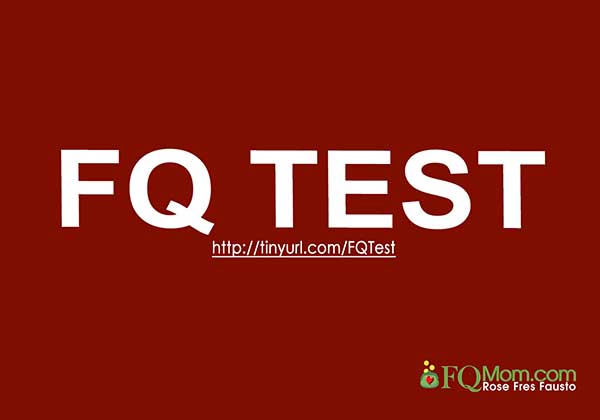PERA-PERAhan lang! (Personal Equity and Retirement Account)


PERA, which stands for Personal Equity and Retirement Account, was launched by the Bangko Sentral ng Pilipinas on Dec. 16, 2016.
“Pera-perahan lang yan!” is a Filipino expression that means “it’s all about the money” or “it all boils down to money!” Well, we see that happening all the time. Ongoing scandal of a wife accusing her husband of ill-gotten wealth when she failed to get the settlement she wanted, law enforcers killing people left and right because of alleged monetary incentives. (Watch Perverse Incentives to know more about it).
Today our discussion of pera-perahan is something that we should all know about. PERA stands for Personal Equity and Retirement Account. It’s the Philippine version of the 401(k) but with a better name. While the US version lacks in creativity in coming up with a name (401(k) is the section of the tax code that governs it), the Pinoy version at least came up with an acronym that is easy to remember and refers to what we all have to prepare for, come retirement years – money, in Filipino PERA! ![]()
PERA was finally launched by the Bangko Sentral ng Pilipinas on Dec. 16, 2016, a long process in the making. I have been hearing about this from The Honey because he helped with the Implementing Rules and Regulations (IRR) of the PERA Act. The law was approved on Aug. 22, 2008. Can you imagine if employees were able to invest in the stock market through the PERA in 2008? The yearend index of the Philippine Stock Exchange then was 1,872.85! Wow! That’s more than quadrupling your investments in less than nine years!
It was challenging to balance what the intention of the law was with the tax collection concerns of the BIR. While PERA aims to encourage the general public to save for their retirement by providing tax incentives, BIR was concerned with lost tax revenues making them unable to meet their collection targets.
Basic Features of PERA
1. PERA is a voluntary and personal account established by and for the exclusive use of and benefit of the Contributor for the purpose of being invested solely in PERA investment products.
2. The parties to a PERA are the following:
-
Contributor – a natural person who establishes and contributes/deposits to the account; has a Tax Identification Number (TIN); has the capacity to contract.
-
Administrator – an entity which had been pre-qualified by the concerned regulatory authority (BSP, SEC or IC) and accredited by the BIR and is responsible for administering and overseeing the PERA of the Contributor.
-
Investment Manager – a regulated entity accredited by the concerned Regulatory Authority (BSP, SEC or IC), that is authorized by the Contributor to make investment decisions for his PERA.
-
Custodian – a separate and distinct entity unrelated to the Administrator, accredited by the BSP to take custody of PERA assets. There are two types:
i. Cash Custodian – shall maintain custody of all funds in connection with PERA.
ii. Securities Custodian – shall maintain custody of all securities, evidence of deposits and other evidence of investment.
3. The requirements in establishing a PERA
-
The Contributor’s PERA must not exceed five at any one time (i.e. five accounts)
-
The maximum total contribution should not exceed
i. P100,000 per year for Filipinos working in the country
ii. P200,000 for Overseas Filipino Workers (OFWs)
*Anything in excess shall not be accepted by the Administrator under the PERA account but may be accepted as other Savings or Investment Account.
-
There should only be one Administrator for all the Contributor’s PERA.
-
Each PERA shall be confined to one category of investment product.
-
Submission of proof of income earnings for the year to be earned for the year the PERA contribution was made.
4. The employer can contribute on behalf of the employee but will also be subject to the limits above. Note that employer’s contribution to PERA are in addition to, and not in lieu of its contribution to SSS and its obligation to pay retirement benefits to its employees under the Labor Code.
5. Benefits from PERA:
-
Contributors are entitled to a tax credit in the amount of 5 percent of the aggregate qualified PERA contributions made in one calendar year. (e.g. If you contributed P100,000 for the year, you shall be issued a Tax Certificate of Entitlement of P5,000 which you can use against your income tax liability. For OFWs, you may use the TCC against any national internal tax revenue tax liabilities).
-
The employer who contributes to the employee’s PERA can claim the actual amount of Qualified Employer’s Contribution as a deduction to his gross income, and shall be exempt from withholding tax on compensation. On the part of the employee, that PERA contribution shouldered by his employer shall not form part of his gross taxable income; hence, exempt from the withholding tax on income (compensation or fringe benefits).
6. Tax Exempt Investment Income
Income earned from investments and reinvestments of PERA assets in the maximum amount allowed is exempt from the following taxes:
-
The final withholding tax on interest from any currency bank deposit, yield or any other monetary benefit from deposit substitutes and from trust funds, including depository bank under the expanded foreign currency deposit system
-
The capital gains tax on the sale, exchange, retirement or maturity of bonds, debentures or other certificate of indebtedness
-
The 10 percent tax on cash and/or property actually or constructively received from a domestic corporation, including a mutual fund company
-
The capital gains tax on the sale, barter, exchange or other disposition of shares of stock in a domestic corporation
-
Regular income tax
7. What is a Qualified PERA Distribution? Qualified Distribution is the distribution of the PERA assets upon Contributor’s:
-
Reaching the age of 55 and made Qualified Contributions for at least 5 years (need not be consecutive)
-
Death, irrespective of the age of the Contributor or yearly Contributions made
8. How may Qualified Distribution be paid out?
Qualified Distributions can be distributed in a lump sum, as pension for a definite period or as a lifetime pension.
US Experience
The 401(k) was introduced in the 1980s as a supplement to pensions. Most employers used to offer pension funds to their employees. They were managed and paid out a steady income over the course of retirement. As the cost of running pensions escalated, employers started replacing these “defined benefit plans” with the 401(k), a form of “defined contribution plan.” So the supplement became the primary source of retirement income for employees. Inasmuch as the 401(k) might look attractive on paper due to the control given to the employee – how you want your money invested, percentage contributions, etc., it has proven insufficient.
Philippine scenario and challenges
Recently launched as it is, the PERA still faces a lot of challenges. Very few PERA accounts have been opened. The process appears to be very tedious. There are no compelling incentives for the employees/employers, administrators, investment managers and custodians to push PERA. Even PERA’s first accredited bank which is the country’s largest bank has a dismally low number of participants to date.
We will be discussing this matter with the head of the Trust Department of BDO for our FQwentuhan. Hopefully, once the kinks are ironed out, we all get to enjoy the tax incentives and other benefits from PERA in order to prepare for a happier retirement. ![]()
*******************************
ANNOUNCEMENT
FQwentuhan tomorrow at noon will be with Ador Abrogena, the head of BDO Trust Department, the first PERA accredited bank.

Want to know your FQ score? Take it today. Click link to take the test. http://tinyurl.com/FQTest

Rose FresFausto is a speaker and author of bestselling books "Raising Pinoy Boys" and "The Retelling of The Richest Man in Babylon" (English and Filipino versions). Click this link to read samples – Books of FQ Mom Rose Fres Fausto. She is a behavioral economist, a certified gallup strengths coach and the grand prize winner of the first Sinag Financial Literacy Digital Journalism Awards. Follow her on Facebook and You Tube as FQ Mom, and Twitter & Instagram as theFQMom.



















